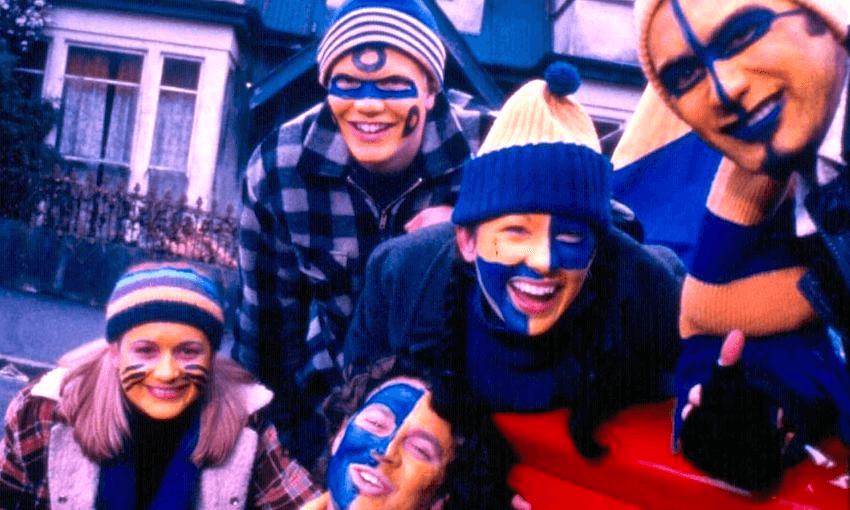Still call Otago University students scarfies? Bad news: you’re hopelessly out of date. These days they’re known as ‘breathers’ – and nobody is quite sure why.
A version of this story first appeared in Critic Te Arohi, the University of Otago student magazine.
For years, Otago students were “scarfies”. The word was popularised by the eponymous 1999 film featuring a pre-stardom Taika Waititi, and came loaded with half a century of resentment from older Dunedin residents forced to put up with the drunken students in their midst. As ubiquitous as the “scarfie” moniker once was, though, it has increasingly been replaced by a newer, more confusing title: “breather”.
Where did all these breathers come from, and how did they destroy the scarfie? My search for answers started where all high-level linguistic research begins: Urban Dictionary.
The first mention of “breather”, in its New Zealand context, popped up in 2012. “Brother or bro when reffering [sic] to a friend. Mostly used in new zealand by boys. In replacement of BRO,” wrote an Urban Dictionary user called “mother of god ;)”. The example they gave was “churr breather ;)”.
Puttin aside the misleading use of winky faces and extremely 2012 slang (“churr”), this user-submitted definition sheds light on the origins of “breather” and helps explain why it was adopted so quickly by students. It’s just “brother” with different vowel sounds. It also explains the informal “breatha” as the logical progression of the student dialect.
The notion of being being a “breather” is also linked to being a waste of space, according to some of the more misanthropic definitions on Urban Dictionary. “They take up too much oxygen breathing my air,” wrote user Kathylu in 2010. This may seem harsh, but in context of the other decidedly scatological definitions on the same page, it’s actually kind of charitable.
This takes us to the very ‘80s-nerd-film insult, “mouth-breather”. The term evolved from a technical term used by doctors to a slang term meaning “idiot” by 1915, according to Jonathon Green, a lexicographer and expert in slang. Ever since, “mouth-breather” has meant a stupid person in numerous English-speaking countries. It’s not too much of a stretch to imagine that, over the decades, we students got too lazy or too intoxicated to bother with the “mouth” in “mouth-breather”, eventually using “breather” to lovingly insult our collective subculture.
Here in Otago, at least, the meaning of the word seems to be a combination of “mouth-breather” and “brother”, creating a person who is your bro but also a waste of space. That brings us to Urban Dictionary’s most up-voted definition of “breather”:
“Almost the entire opposite to a fuckboy. This specimen lives entirely for the boys, and devotes their life to putting smiles on their friends’ faces, through particular acts such as shoey’s, rhinos, and getting naked,” wrote Breathersaurus in 2018.
This is the breather we all know and love.
Critic’s first use of “breather” in a student context was in 2016. This momentous debut, alongside Google Trends data, cements 2016 as year zero for Otago University’s usage of the word.
That first Critic mention was in a blind date column, wherein two horny students would be set up, go on a date, and anonymously log their debauchery for the city to read. In the column published on Sunday 13 March 2016, the “his” paragraph read, in part: “After a self diagnosis of soberness I decided to self medicate and inhaled a cheeky few diesels to loosen up with the breathers beforehand.”
Whoever this anonymous young man is, he is responsible for the first published use of the word in an Otago University context. Little did he know he would influence a generation.
The rest is history: “breather” has now almost entirely supplanted “scarfie”. The etymology of the latter is easy to trace, thanks to extensive research already conducted: it came from students wearing scarves around their necks to survive the bitter winters of Dunedin. In 2006 Ian Wards, curator of the Otago Museum exhibition Scarfies: Otago Student Culture, said that “scarfie” had been in use for 20 to 30 years, placing its birth around the early 1980s.
Here’s my theory: the decline of “scarfie” could be all about wool. A decline in supply – and increase in price – began around 2015 and really got going around 2016, the inaugural year of the breather. Thus the rise of the breather may be directly linked to New Zealand’s wool supply, or climate change, it’s hard to tell. The end result is the same, however: these days, no one under the age of 27 would ever describe themselves as a scarfie.
“Scarfie” does have one important advantage. People of any gender can be a scarfie, making it a more inclusive term. In contrast, many students reckon that to be a “breather” is to be a member of a new kind of old boys club. But this is 2021. It’s been a full five years since the emergence of the breather, so goddamn it, just make it gender neutral already.
But don’t get too used to it. If history is any guide, students will be using an entirely new word to describe themselves by the time your own kids head off to university.
